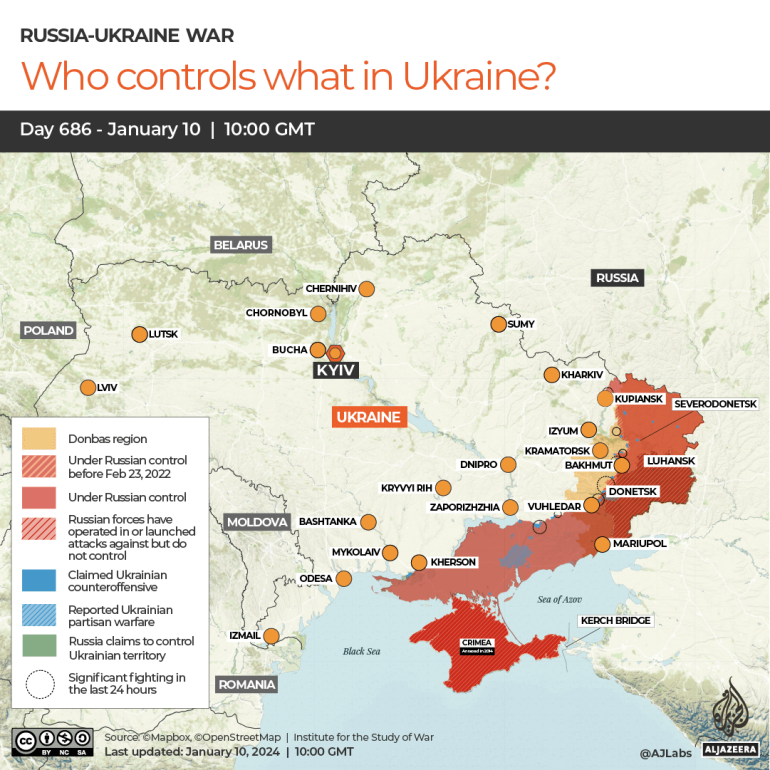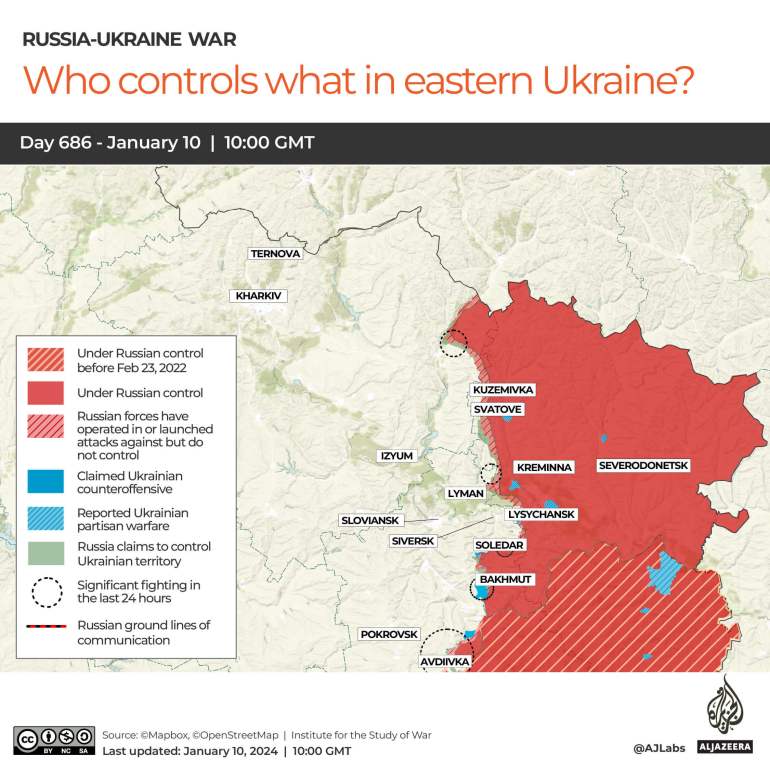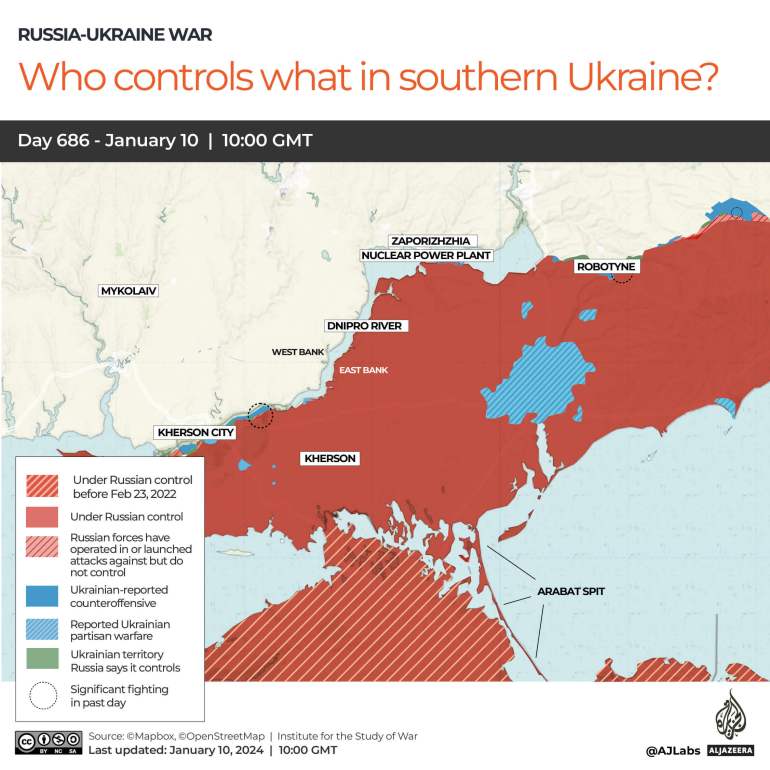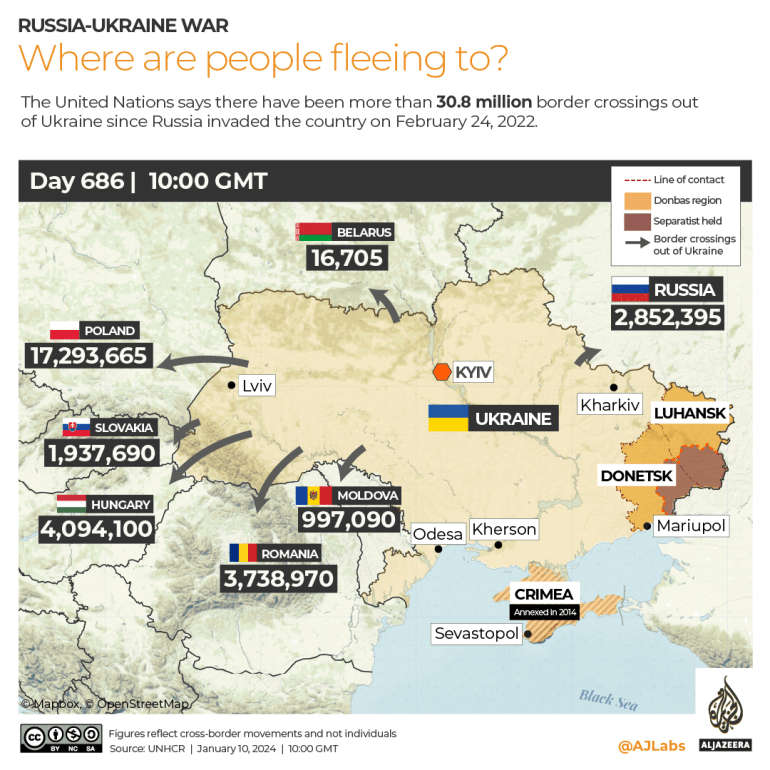Russia appears to be doubling down on glide bombs and ballistic missiles – unsophisticated, inexpensive bombs difficult to intercept – as well as drones, as its strategy for inflicting a new wave of destruction on Ukraine’s cities and infrastructure.
Since December 29, Russia has launched almost daily barrages of drones and missiles of various types at Ukraine to probe for weaknesses in its aerial defences.
Ukraine has been downing almost all of the drones and an impressive ratio of missiles.
That changed on Monday, when Ukraine intercepted only 18 of a cocktail of 51 missiles Russia fired at the regions of Kharkiv, Dnipropetrovsk, Zaporizhia and Khmelnytskyi.
Those that got through killed at least four civilians.
Part of Russia’s success appeared to be the use of six Iskander and eight Kinzhal ballistic missiles.
These travel at terminal speeds of 9,000-12,000km/h (5,600 to 7,500mph) and are very difficult to intercept.
Unlike cruise missiles, they can also be rendered immune to electronic warfare that interferes with GPS guidance because they carry inertial guidance systems that navigate by dead reckoning.
Another reason for Russia’s success appeared to be that it had mapped weaknesses in Ukraine’s air defence over days of attacks.
Ukrainian Air Force spokesman Yuri Ignat told reporters these two reasons explained the low kill rate on Monday.
“The explanation is simple: they were flying on a ballistic trajectory, and into the regions where we can’t shoot them down,” Ignat said.
Short-range ballistic missiles “appear to be more effective at penetrating or avoiding Ukrainian air defences,” said the Institute for the Study of War, a Washington-based think tank.
“Ukrainian air defences have intercepted 149 of a reported 166 Russian cruise missiles in intensified attacks since December 29, but have only intercepted a handful of the ballistic missiles that Russia has launched at Ukraine in the same period,” it said.
Russia can only produce about 42 Iskander missiles and four Kinzhal missiles a month, said the ISW, and was enlisting the production capabilities of Iran and North Korea to overwhelm Ukraine with firepower.
US national security spokesman John Kirby told a White House briefing on January 4 Russia had used North Korean ballistic missiles against Ukraine on December 30 and January 2.
Ukraine agreed.
“There is no longer any disguise … as part of its outright genocidal war, the Russian Federation for the first time struck at the territory of Ukraine with missiles received from … North Korea,” said Mykhailo Podolyak, an adviser to Ukrainian President Volodymyr Zelenskyy.
A weapons expert told Reuters that the missile appeared to be a North Korean KN-23.
“We are deeply concerned about the security implications that this cooperation has in Europe, on the Korean Peninsula, across the Indo-Pacific region, and around the world,” said a joint statement signed by the United States, United Kingdom, the European Union, Australia, Germany, Canada and nearly 40 other partner nations.
There was further concern “that Russian negotiations to acquire close-range ballistic missiles from Iran are actively advancing”, Kirby told journalists.
Such missiles could be traded for Russian long-range, nuclear-capable ballistic missile technology, Russia said last October. North Korea has also expressed interest in the technology.
Glide bombs and drones
Russia has also experimented with glide bombs against Ukrainian front lines in the past few months with considerable success. These are air-launched free-fall bombs fitted with adjustable fins that enable them to fly further and navigate – but they are far cheaper to produce than guided missiles and are also immune to jamming.
Glide bombs’ weakness is that aircraft must bring them to within about 25km (16 miles) of their target, exposing them to enemy fire. Ukraine seized such opportunities to down four Russian Sukhoi-34 bombers in the last week of December.
But Russia evidently considers the bombs a success worth developing.
On Wednesday, the state-owned TASS news agency said Russia would put a new glide bomb into production, without specifying its capabilities, suggesting that it has engineered improvements. The Drel glide bombs are to enter active service this year and may present a new challenge to Ukrainian defenders.
Russia also said it will invest $7.7bn in almost tripling domestic drone production by 2030, said First Deputy Prime Minister Andrei Belousov on January 6. “The annual production volume of unmanned aerial vehicles (UAVs) – excluding educational UAVs – is planned at 32,500 units,” Belousov told TASS. “This is almost three times higher than current production volumes.”
Put together, the three technologies – glide bombs, ballistic missiles and drones – could overwhelm Ukraine’s ability to intercept them.
“It is clear that there is a shortage of anti-aircraft guided missiles, no one hides it,” Ukrainian Air Force spokesman Yuri Ignat told a news conference on Tuesday, after Russia had launched about 500 missiles and drones over several days, consuming intercept missiles. 
NATO’s Support and Procurement Agency said this week it would spend $5.5bn to support the procurement of 1,000 Patriot missiles for members and create a Patriot production plant in Germany, but it was not clear that any of the new missiles would go to Ukraine.
To economise on Patriot missiles, Ukraine has increased its kill rate of Shahed drones using mobile air defence units carried on pick-up trucks. Sometimes, these are sophisticated man-portable air defence surface-to-air guided missiles. Sometimes, they are nothing more than World War II-era MG42 heavy machine guns.
Ukraine’s long reach
Ukraine also targeted Russian military installations from afar, setting its sights in particular on the Saky airfield on the Crimean Peninsula.
Russia claimed to have fended off a large wave of Ukrainian drones and missiles targeting Saky on Friday.
Ukraine claimed success in Saky on Saturday, when Ukraine’s defence intelligence and air force said they led an operation to take out Russian radar positions around the Saky airfield.
Russian sources said up to four Storm Shadow cruise missiles struck an administrative building at the Saky airfield on the same day.
The defence intelligence operation also destroyed an ammunition depot at the village of Hryshyne.
There were other attempts to attack targets in Crimea during the week, some successful. Ukraine claimed to have destroyed a communications centre in the Crimean city of Yevpatoria, which co-ordinated Crimean air defence.
Ukrainian missiles also struck a Russian command post near the Crimean port of Sevastopol on January 3.
But much more damage was clearly intended. Russia claimed to have shot down 10 Ukrainian missiles over Crimea on January 3, another 36 Ukrainian drones over Crimea and a Neptune missile over the Black Sea on Friday, and another five drones and 10 missiles on January 6.
Ukraine’s most important success of the week may have been destroying a bridge Russia was building to better supply its forces in southern Ukraine, disrupting a major intended logistics artery.
“The Ukrainians … set back almost a half-year of serious Russian supply planning,” wrote Stefan Korsha, a senior defence correspondent at Kyiv Post. Petro Andriushchenko, adviser to the mayor of Mariupol, said, “Now the launch of a direct railway from Russia is closed for a long time.”
Ukraine also scored successes in Russia itself.
On January 4, a Ukrainian defence intelligence operation destroyed a Sukhoi-34 bomber on the Shagol airfield in Chelyabinsk, 1,500km (932 miles) east of Moscow, Ukraine said.
The next day Ukraine’s defence intelligence said one of its units destroyed two Pantsir-S1 air defence units in the Russian region of Belgorod, north of Ukraine.
And on Monday Russian media reported a blast on a section of railway near the city of Nizhny Tagil, 1,400km (870 miles) east of Moscow.
Russia claimed to have shot down 10 airborne targets over the city of Belgorod on January 4.
Russia doubles down on fast, cheap, unguided bombs to attack Ukraine - Al Jazeera English
Read More
No comments:
Post a Comment